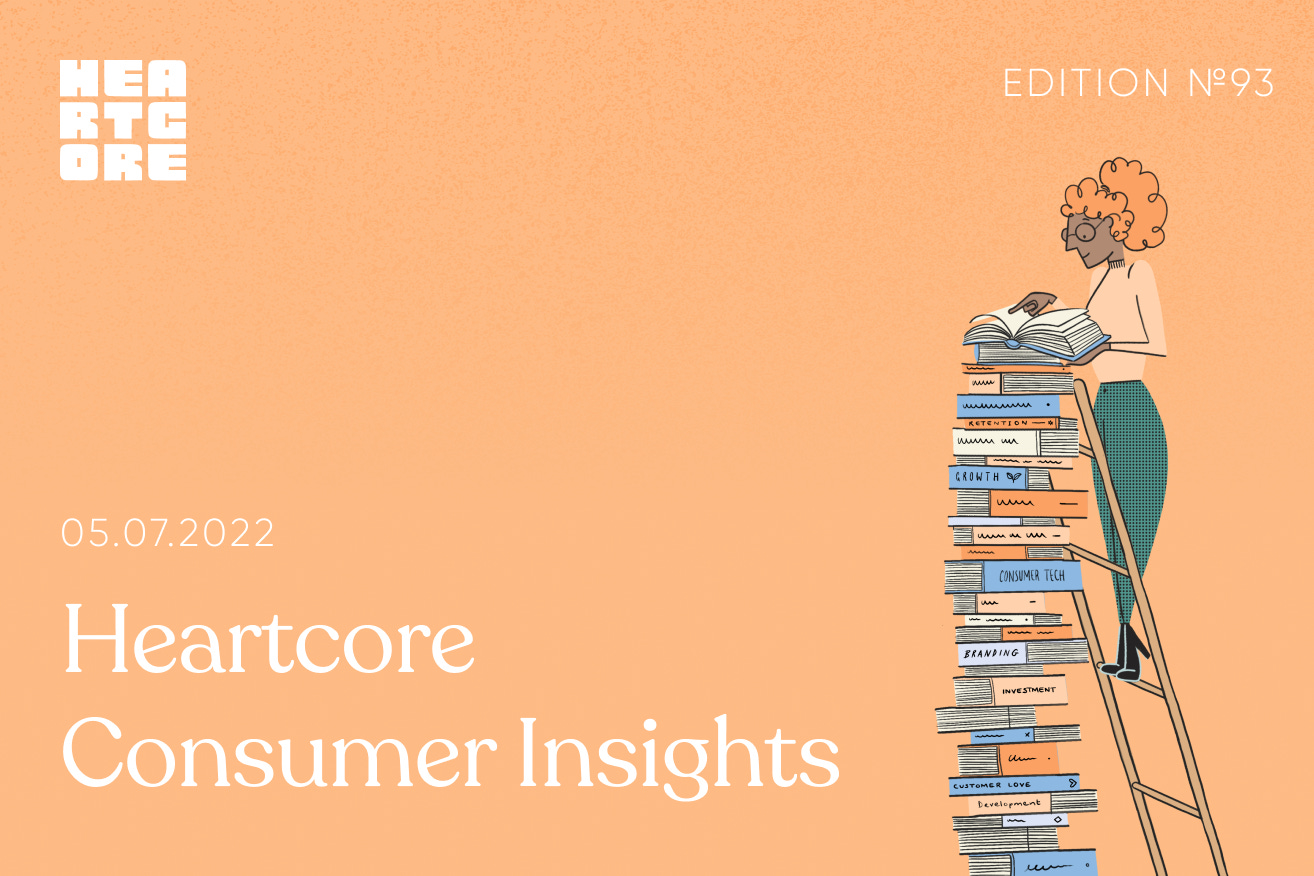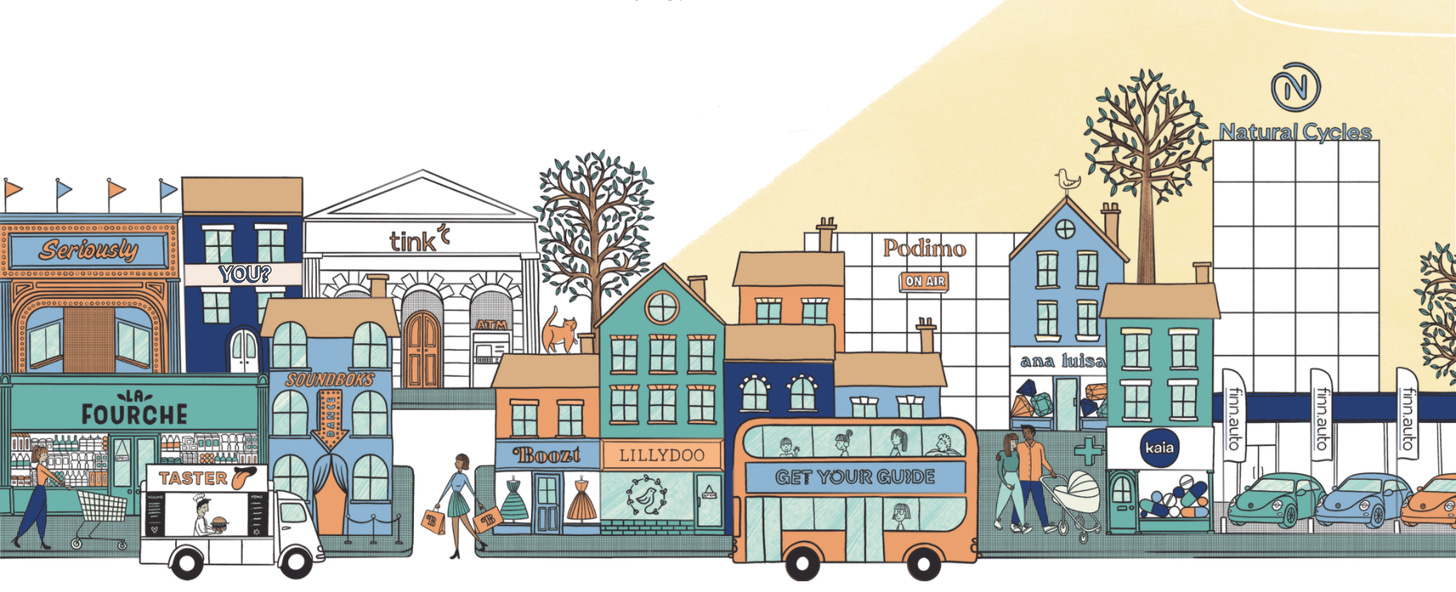Hi there,
Welcome to the 93rd edition of Heartcore Consumer Insights. Curated with 🖤 every two weeks by the Heartcore Team.
If you missed the past newsletters, you can catch up here. Now, let’s dive in!
What is a “brand”? Interview with Inés Ures (former CMO @Deliveroo & @Treatwell)
What is a brand?
A strong brand is an abstract entity that people are going to want to be part of, something that’s almost like a religion. Many people focus on visual attributes - what a brand looks like or its tone of voice. These are important elements but, ultimately, the brand is more than that. The mission can be as simple as “we are bringing the cheapest groceries to you”, but whatever you choose you have to truly deliver on that promise. Then, once you have that, you can start developing all the different brand components - the look, the voice, the communication pillars, the channels, etc.
How do you actually go about turning the mission into a brand?
Let’s go back to the example of a mission to deliver the cheapest groceries. If that’s truly your promise, you’ll develop a series of programs that will help you deliver on that promise. For example, you’ll have price comparison tools, you’ll offer money-back price guarantees and so if they can buy it cheaper somewhere else, you’ll refund them the difference and so on. And once you start delivering these programs, people will start to believe that you are the “religion” of the cheapest products. And, again, the brand is not just about how it looks and feels, it’s about what it actually does. Otherwise, people don’t trust your brand. So, if you promise that “when you come to brand ABC, you will always have the cheapest products” you need to deliver on it.
When should a founder start thinking about the brand element of their business, and actually start investing in it?
From day one. If from day one you have a brand marketing budget in your P&L - around 5% of the 20-30% that’s usually dedicated to marketing - the day you get to $100M in revenue, you can continue spending on the brand without any questions asked. And then over time, you’ll spend a lot less on marketing, because you’ve created a brand that leads to more organic growth. It’s very difficult to calculate ROI and justify “creating a brand” once a company becomes very big because the brand has to be rooted in the foundations of the organization. You can’t try to find your legacy when you’ve been operating for five or ten years.
The Growth Competency Model - Reforge
What do the best growth practitioners look like? What makes them great? How do I hire and manage them? How do I know if my organization has what it needs?
The Growth Competency Model provides a framework to identify and answer these questions.
Cherry-picked advice from the framework:
Channel Fluency: the ability to mold your product & marketing to fit an ever-changing channel landscape is critical. Yes, everyone is on Facebook, but truck drivers for UberFreight are actively talking about their jobs on YouTube live streams and while socializing at key trucking conferences. Yes, everyone searches for classes on Google and can find a MasterClass, but Neil Gaiman has a very active Reddit group, Ninja's community is on Twitch, and people wanting to learn Metallica songs on the guitar are on YouTube. And all those channels have fundamentally different DNA to spark growth.
Productizing Learnings: as a Growth practitioner, being able to turn an idea or simple experiment into a new product feature is extremely important. Spotify’s Discover Weekly automated playlists actually came from a hackathon idea and insights that showed people wanted more ways to discover new music. Before that new feature, the only ways they were discovering new music were from playlists random people created.
Instrumentation & Data Fluency: knowing SQL or something similar doesn’t actually make you a great growth practitioner. Instead, the best growth practitioners should strive to make data practical for the teams they work with by having a growth model and use cases modeled in a structured way that makes instrumentation and data fluency really shine.
User Psychology: a lot of Growth teams think they deeply understand their customers because they interact with them constantly. But that never tells the whole story. “At Uber, we rode with drivers daily and spoke to them. At LambdaSchool our employees were in the classroom and on slack with customers in real-time. But neither of those scenarios replace BEING a driver, dealing with traffic, gas, safety, and more. Or BEING a student while balancing parenting, internet connection, imposter syndrome, etc.” The best Growth Leaders can navigate and leverage the difference between perceived and actual user psychology or motivations.
Creative & Narrative Development: knowing how to communicate with different customer segments and position your products to address their needs is essential. When Gojeck launched GoPay, an e-wallet, they didn’t get a ton of adoption at first. So they decided to try to activate one of their most powerful levers, the drivers, by establishing the right narrative and context. “We'd tell our drivers if a customer hadn't adopted GoPay yet - and if they did top-up cash with the driver for the first time, the driver would get a bonus.” Once they had established that narrative, the drivers got creative and took it a step further by running their own promotional strategies for each new customer. This led to a large spike in driver-led activation rates to GoPay. All because Gojeck was able to give their best activation lever the right context and information.
The article is full of actionable guidance. We’d definitely encourage interested readers to study the full piece!
Shopify Adds NFT-Gated Option for Online Retailers
Xiaohongshu (Chinese Instagram equivalent) deep-dive
How inflation and the conflict in Ukraine are impacting European consumers
8 common content writing mistakes
Hopper CEO on Super-App Ambitions
2022 Gaming Spotlight Report
🇪🇺 Notable European early-stage Consumer rounds
Bitt-Odd, a Finland-based mobile gaming studio, raises $5.3M with Index - link
Chroma Studios, a Sweden-based startup striving to create a new type of audio entertainment, built specifically for mobile devices, raises $5.5M with Singular/Adjacent/Biz Stone - link
Project Eaden, a Germany-based startup “reinventing plant-based meat from the fiber up”, raises €8M with Creandum - link
Soba, a Germany-based open-world web3 platform where people can create games for any device using easy no-code tools, raises $13.6M with Lightspeed/FTX/Cherry/Point9 - link
Aware, a Germany-based blood test health-check platform, raises $15M with Lakestar/Cherry - link
🇺🇸 Notable US early-stage Consumer rounds
Kairos, a US-based startup providing tools for anyone to create, publish and sell NFTs, raises $2.6M with Seven Seven Six - link
Hank, a US-based platform connecting seniors with people and activities in their community, raises $7M with General Catalyst/Resolute Ventures - link
Aidaly, a US-based startup providing financial services to family caregivers, raises $8.5M with Seven Seven Six/Lightspeed - link
Tenet, a US-based EV-financing platform, raises $18M with Giant Ventures/Human Capital - link
OnChain Studios, a US-based studio behind the NFT-native toy, gaming and entertainment universe “Cryptoys”, raises $23M with a16z - link
Sanas, a US-based startup developing real-time accent translation, raises $32M with GV/General Catalyst - link
The Wildcard Alliance, a US-based Web3 video game studio, raises $46M with Paradigm/Griffin/Polygon - link
🔭 Notable later-stage Consumer rounds
Shop Circle, a UK-based e-commerce tools aggregator, raises $65M with NFX/QED/firstminute/645 - link
Omio, a Germany-based travel search and booking platform, raises $80M with NEA/Temasek - link
Cleo, a UK-based digital finance assistant for Gen Z, raises $80M with Sofina/Balderton/EQT - link
Magic Eden, a US-based NFT marketplace, raises $130M with Electric Capital/Greylock/Sequoia/Lightspeed - link
Rohlik, a Czech-based grocery delivery startup, raises $220M with Sofina/Index - link
🍭 Notable Consumer Exits
Ebay acquires KnownOrigin for an undisclosed amount. KnownOrigin is a US-based digital art and NFT marketplace - link
Heartcore Consumer Insights is a weekly newsletter covering notable consumer rounds and exits and top content in the B2C space.









